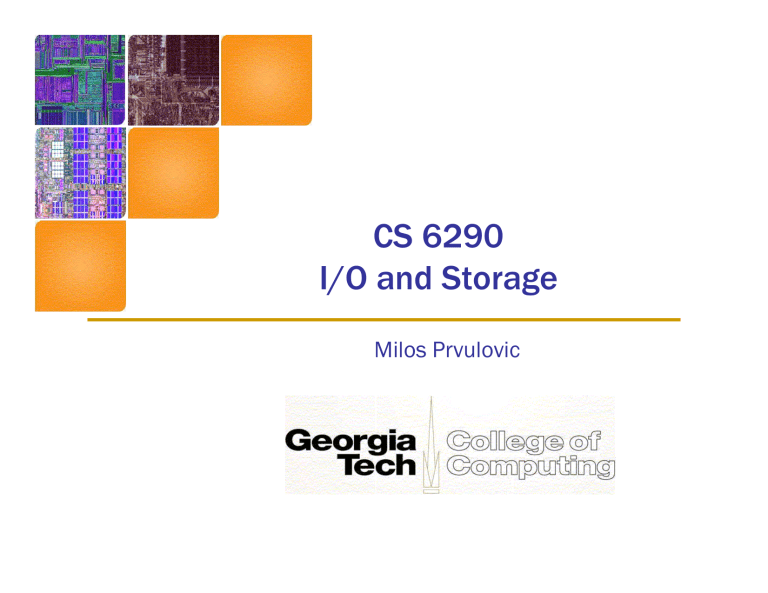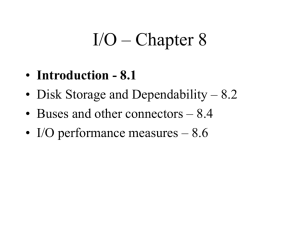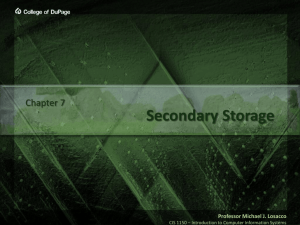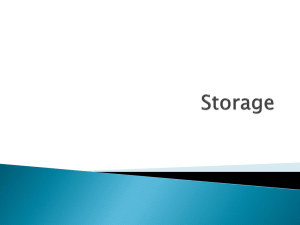CS 6290 I/O and Storage Milos Prvulovic

CS 6290
I/O and Storage
Milos Prvulovic
Storage Systems
• I/O performance (bandwidth, latency)
– Bandwidth improving, but not as fast as CPU
– Latency improving very slowly
– Consequently, by Amdahl’s Law: fraction of time spent on I/O increasing
• Other factors just as important
– Reliability, Availability, Dependability
• Storage devices very diverse
– Magnetic disks, tapes, CDs, DVDs, flash
– Different advantages/disadvantages and uses
Magnetic Disks
Magnetic Disks
• Good: cheap ($/MB), fairly reliable
– Primary storage, memory swapping
• Bad: Can only read/write an entire sector
– Can not be directly addressed as main memory
• Disk access time
– Queuing delay
• Wait until disk gets to do this operation
– Seek time
• Head moves to correct track
– Rotational latency
• Correct sector must get under the head
– Data transfer time and controller time
Trends for Magnetic Disks
• Capacity: doubles in approx. one year
• Average seek time
– 5-12ms, very slow improvement
• Average rotational latency (1/2 full rotation)
– 5,000 RPM to 10,000 RPM to 15,000 RPM
– Improves slowly, not easy (reliability, noise)
• Data transfer rate
– Improves at an OK rate
•New interfaces, more data per track
Optical Disks
• Improvement limited by standards
– CD and DVD capacity fixed over years
– Technology actually improves, but it takes time for it to make it into new standards
• Physically small, Replaceable
– Good for backups and carrying around
Magnetic Tapes
• Very long access latency
– Must rewind tape to correct place for read/write
• Used to be very cheap ($/MB)
– It’s just miles of tape!
– But disks have caught up anyway…
• Used for backup (secondary storage)
– Large capacity & Replaceable
Using RAM for Storage
• Disks are about 100 times cheaper ($/MB)
• DRAM is about 100,000 faster (latency)
• Solid-State Disks
– Actually, a DRAM and a battery
• Much faster than disk, more reliable
• Expensive (not very good for archives and such)
• Flash memory
– Much faster than disks, but slower than DRAM
– Very low power consumption
– Can be sold in small sizes (few GB, but tiny)
Busses for I/O
• Traditionally, two kinds of busses
– CPU-Memory bus (fast, short)
– I/O bus (can be slower and longer)
• Now: mezanine busses (PCI)
– Pretty fast and relatively short
– Can connect fast devices directly
– Can connect to longer, slower I/O busses
• Data transfers over a bus: transactions
Buses in a System
Bus Design Decisions
• Split transactions
– Traditionally, bus stays occupied between request and response on a read
– Now, get bus, send request, free bus
(when response ready, get bus, send response, free us)
• Bus mastering
– Which devices can initiate transfers on the bus
– CPU can always be the master
– But we can also allow other devices to be masters
– With multiple masters, need arbitration
CPU-Device Interface
• Devices typically accessible to CPU through control and data registers
• These registers can be either
– Memory mapped
• Some physical memory addresses actually map to I/O device registers
• Read/write through LS/ST
• Most RISC processors support only this kind of I/O mapping
– Be in a separate I/O address space
• Read/write through special IN/OUT instrs
• Used in x86, but even in x86 PCs some I/O is memory mapped
CPU-Device Interface
• Devices can be very slow
– When given some data, a device may take a long time to become ready to receive more
– Usually we have a Done bit in status register
• Checking the Done bit
– Polling: test the Done bit in a loop
– Interrupt: interrupt CPU when Done bit becomes 1
– Interrupts if I/O events infrequent or if device is slow
• Each interrupt has some OS and HW overhead
– Polling better for devices that are done quickly
• Even then, buffering data in the device lets us use interrupts
– Interrupt-driven I/O used today in most systems
Dependability
• Quality of delivered service that justifies us relying on the system to provide that service
– Delivered service is the actual behavior
– Each module has an ideal specified behavior
• Faults, Errors, Failures
– Failure: actual deviates from specified behavior
– Error: defect that results in failure
– Fault: cause of error
Failure Example
• A programming mistake is a fault
– An add function that works fine, except when we try 5+3, in which case it returns 7 instead of 8
– It is a latent error until activated
• An activated fault becomes effective error
– We call our add and it returns 7 for 5+3
• Failure when error results in deviation in behavior
– E.g. we schedule a meeting for the 7 th instead of 8 th
– An effective error need not result in a failure
(if we never use the result of this add, no failure)
Reliability and Availability
• System can be in one of two states
– Service Accomplishment
– Service Interruption
• Reliability
– Measure of continuous service accomplishment
– Typically, Mean Time To Failure (MTTF)
• Availability
– Service accomplishment as a fraction of overall time
– Also looks at Mean Time To Repair (MTTR)
• MTTR is the average duration of service interruption
– Availability=MTTF/(MTTF+MTTR)
Faults Classified by Cause
• Hardware Faults
– Hardware devices fail to perform as designed
• Design Faults
– Faults in software and some faults in HW
– E.g. the Pentium FDIV bug was a design fault
• Operation Faults
– Operator and user mistakes
• Environmental Faults
– Fire, power failure, sabotage, etc.
Faults Classified by Duration
• Transient Faults
– Last for a limited time and are not recurring
– An alpha particle can flip a bit in memory but usually does not damage the memory HW
• Intermittent Faults
– Last for a limited time but are recurring
– E.g. overclocked system works fine for a while, but then crashes… then we reboot it and it does it again
• Permanent Faults
– Do not get corrected when time passes
– E.g. the processor has a large round hole in it because we wanted to see what’s inside…
Improving Reliability
• Fault Avoidance
– Prevent occurrence of faults by construction
• Fault Tolerance
– Prevent faults from becoming failures
– Typically done through redundancy
• Error Removal
– Removing latent errors by verification
• Error Forecasting
– Estimate presence, creation, and consequences of errors
Disk Fault Tolerance with RAID
• Redundant Array of Inexpensive Disks
– Several smaller disks play a role of one big disk
• Can improve performance
– Data spread among multiple disks
– Accesses to different disks go in parallel
• Can improve reliability
– Data can be kept with some redundancy
RAID 0
• Striping used to improve performance
– Data stored on disks in array so that consecutive
“stripes” of data are stored on different disks
– Makes disks share the load, improving
•Throughput: all disks can work in parallel
•Latency: less queuing delay – a queue for each disk
• No Redundancy
– Reliability actually lower than with single disk
(if any disk in array fails, we have a problem)
RAID 1
• Disk mirroring
– Disks paired up, keep identical data
– A write must update copies on both disks
– A read can read any of the two copies
• Improved performance and reliability
– Can do more reads per unit time
– If one disk fails, its mirror still has the data
• If we have more than 2 disks (e.g. 8 disks)
– “Striped mirrors” (RAID 1+0)
• Pair disks for mirroring, striping across the 4 pairs
– “Mirrored stripes” (RAID 0+1)
• Do striping using 4 disks, then mirror that using the other 4
RAID 4
• Block-interleaved parity
– One disk is a parity disk, keeps parity blocks
– Parity block at position X is the parity for all blocks whose position is X on any of the data disks
– A read accesses only the data disk where the data is
– A write must update the data block and its parity block
– Can recover from an error on any one disk
• Use parity and other data disks to restore lost data
– Note that with N disks we have N-1 data disks and only one parity disk, but can still recover when one disk fails
– But write performance worse than with one disk
(all writes must read and then write the parity disk)
RAID 4 Parity Update
RAID 5
• Distributed block-interleaved parity
– Like RAID 4, but parity blocks distributed to all disks
– Read accesses only the data disk where the data is
– A write must update the data block and its parity block
• But now all disks share the parity update load
RAID 6
• Two different (P and Q) check blocks
– Each protection group has
• N-2 data blocks
• One parity block
• Another check block (not the same as parity)
• Can recover when two disks are lost
– Think of P as the sum and Q as the product of D blocks
– If two blocks are missing, solve equations to get both back
• More space overhead (only N-2 of N are data)
• More write overhead (must update both P and Q)
– P and Q still distributed like in RAID 5





